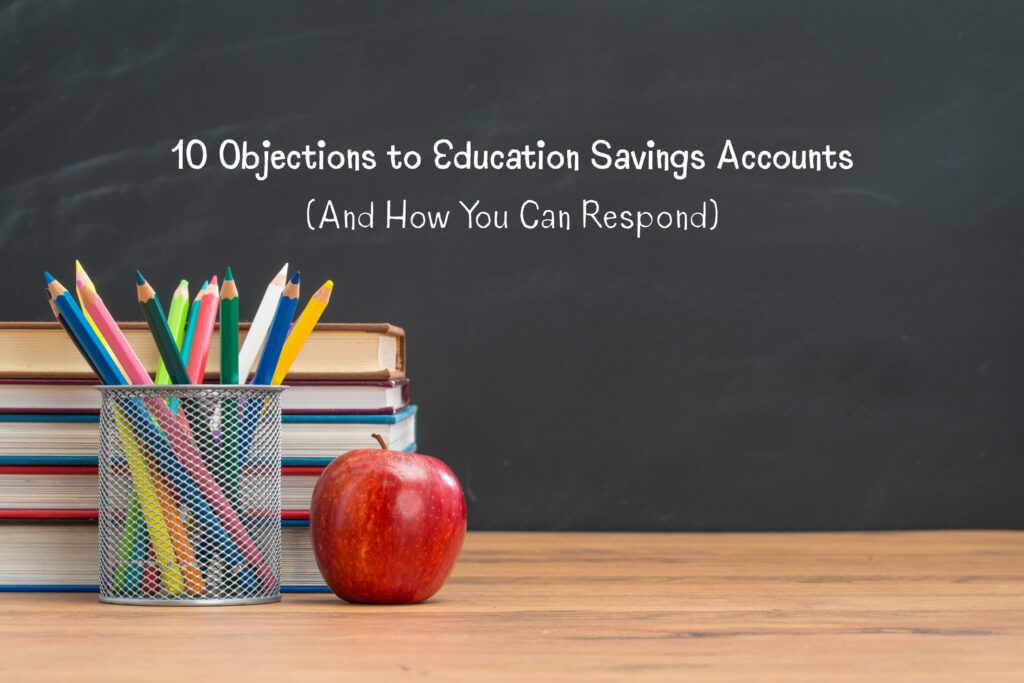Education Savings Accounts (ESAs) are a major topic of discussion in Iowa and across the nation. Supporters see them as a way to empower families with real choices, while opponents raise objections rooted in concerns about funding, fairness, and accountability. For those who support ESAs, knowing how to respond to these objections is key to having productive conversations with those who are on the fence.
Here are ten common objections to ESAs—and thoughtful ways to respond.
1. “ESAs take money away from public schools.”
Response: ESAs don’t defund public schools—they empower families to choose the best setting for their child. Funding follows the student, not the system. Public schools still receive significant per-pupil funding even when a child leaves, and studies show school choice often improves public school performance through healthy competition.
2. “Private schools aren’t accountable like public schools are.”
Response: Accredited private schools must meet state standards, including testing and accreditation requirements. Many also use national assessments to track growth. Real accountability comes from parents: if a school doesn’t serve families well, they can take their child—and ESA funds—elsewhere.
3. “ESAs are just a handout for the wealthy.”
Response: The opposite is true. Wealthy families already have educational choices. ESAs level the playing field by giving middle- and lower-income families the financial means to access private schools, homeschooling resources, or other opportunities that were previously out of reach.
4. “Rural families won’t benefit from ESAs.”
Response: In Iowa, ESA funds must first be used for private school tuition. That can make ESAs seem less relevant in rural areas without many private schools. But many rural families already enroll in nonpublic schools within driving distance, and ESAs help ease that financial burden. Just as importantly, ESAs are sparking the creation of new private schools across the state, including in smaller communities where families want additional options. Once tuition is covered, any remaining funds can also support other educational needs such as tutoring, curriculum, or special services. Rather than leaving rural families behind, ESAs are helping expand opportunities.
5. “School choice promotes discrimination.”
Response: ESAs expand opportunity for all families, regardless of background. Choice programs in other states have often increased diversity by allowing families to look beyond zip codes. And private schools must still follow state and federal non-discrimination laws.
6. “Public funds shouldn’t go to private or religious schools.”
Response: ESA funds are for the student, not the system. Parents decide where that funding is used. Courts have consistently ruled that when parents make the decision, ESAs are constitutional—even if they choose a faith-based school.
7. “ESAs will drain the state budget.”
Response: ESAs are usually less costly per pupil than public school funding. That means the state spends less when a student uses an ESA. Meanwhile, local districts keep some funding for students they no longer educate.
8. “ESAs will just cause private schools to raise tuition.”
Response: Some worry that ESAs give schools an excuse to hike prices. But tuition decisions depend on many factors—staffing, facilities, and local demand. In practice, competition among schools keeps tuition in check, since families can walk away if prices get too high. ESAs actually increase market pressure on schools to remain affordable and attractive to families, not less. Moreover, as more private schools open in response to demand, increased supply makes tuition inflation less likely, not more.
9. “Private schools can turn away kids with special needs.”
Response: Not every school—public or private—has the resources to serve every special need. But ESAs give parents more flexibility to find the right fit, whether that’s a specialized private program, therapies, or a combination of supports. Instead of limiting choices, ESAs expand them.
10. “ESAs will create chaos and weaken our education system.”
Response: Far from causing chaos, ESAs encourage innovation and responsiveness. When parents have real choices, schools must work harder to meet student needs. The result is not a weaker system, but a stronger one centered on students instead of bureaucracy.
Conclusion
Objections to ESAs often come from misunderstandings or fears about change. Parents and grandparents who support school choice can help by calmly addressing these concerns and explaining how ESAs work. At the heart of the issue is a simple truth: every child deserves access to the education that fits them best. ESAs are one tool to make that vision a reality for families across Iowa.
